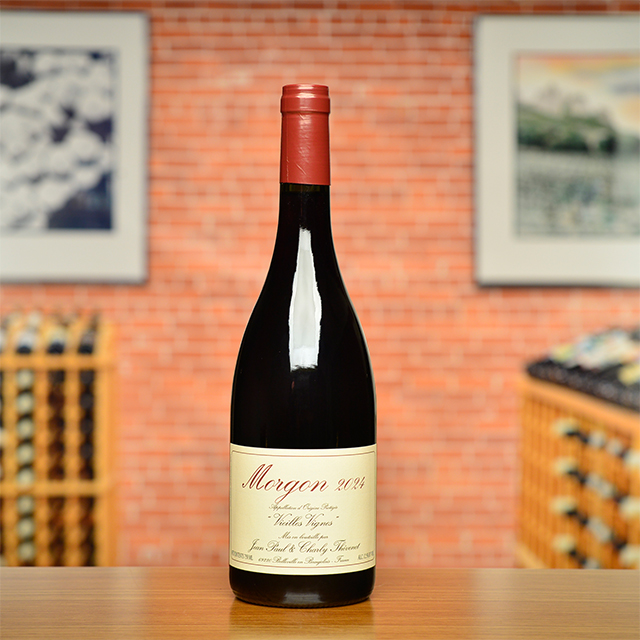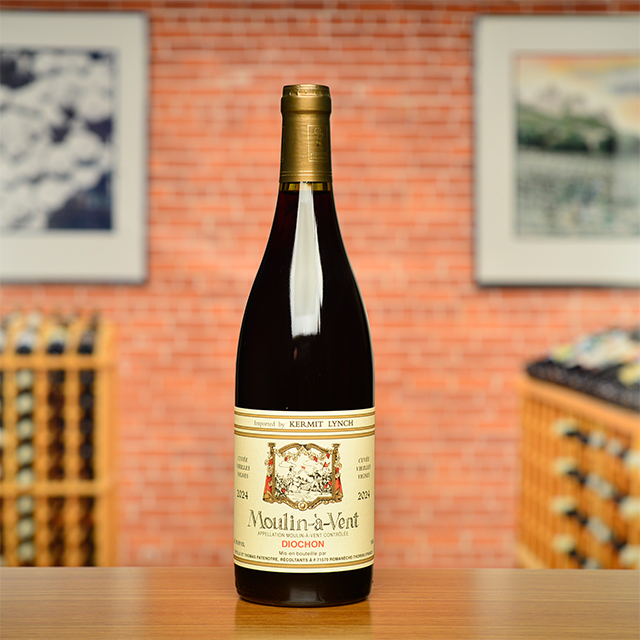Notify me
2018 Régnié “Grain & Granit”
Jean-Paul et Charly Thévenet
Charly Thévenet
The son of “gang of four” Morgon producer Jean-Paul Thévenet, Charly had early exposure to the world of organic farming and natural winemaking. Passionate about the family business, he struck out on his own as soon as the opportunity presented itself, purchasing a parcel of eighty-year-old vines in the neighboring cru of Régnié. Today, he works side by side with his father, collaborating in the production of both wines. As with the Morgon, Charly’s Régnié grapes are harvested when fully ripe, by hand, then vinified via whole-cluster fermentation, in typical Beaujolais fashion. The wine is aged in concrete tanks before bottling without fining or filtration. The 2018 vintage gives us a rich, bold, and spicy Régnié, saturated with luscious fruit and earthy funk. Serve it with grilled sausages, or let it sit in your cellar for three or four more years before uncorking.
—Anthony Lynch
| Wine Type: | red |
| Vintage: | 2018 |
| Bottle Size: | 750mL |
| Blend: | Gamay |
| Appellation: | Régnié |
| Country: | France |
| Region: | Beaujolais |
| Producer: | Jean-Paul et Charly Thévenet |
| Vineyard: | 80 yrs +, 3 ha |
| Soil: | Granite |
| Aging: | Aged in concrete tanks, no fining or filtration |
| Farming: | Biodynamic (practicing) |
| Alcohol: | 13.5% |
More from this Producer or Region

2023 Fleurie
France | Beaujolais
Light and living, charged with herbs, cranberry, and strawberry.

2024 Brouilly “Reverdon”
France | Beaujolais
This bottling is classic Brouilly, balanced and old-school, and showcases the beauty of Gamay.

2024 Régnié “Grain & Granit”
France | Beaujolais
Here is a rich, bold Régnié, saturated with luscious fruit and earthy spice.

2024 Beaujolais-Villages
France | Beaujolais
December Club Gourmand ~ This drinks like a Gamay infusion with lovely hints of potpourri, spice, and fresh grapes.

2023 Chénas “Les Blémonts”
France | Beaujolais
Structured yet full of energy, with notes of blueberry, spice, and other things nice.

2023 Chénas “Chassignol”
France | Beaujolais
A finessed, mineral-driven beauty from hundred-year-old vines at the highest point in Chénas.

2021 Beaujolais Blanc “Terrain Rouge”
France | Beaujolais
In classic Thévenet fashion, the wine is bright and energetic—a snappy Chardonnay that tastes like fresh green apple skin with a whisper of gentian.

2024 Morgon “Vieilles Vignes”
France | Beaujolais
December Club Rouge ~ If Beaujolais were Burgundy, we might consider Morgon to be Vosne-Romanée, with its haunting perfume and silky texture, the proverbial iron fist in a velvet glove.

2024 Morgon “La Roche Pilée”
France | Beaujolais
This is textbook Morgon: bright, floral, and spicy, recalling juicy peach and sour cherry.

2024 Moulin-à-Vent “Vieilles Vignes”
France | Beaujolais
Moulin-à-Vent has a unique, earthy, chewy edge to it that you just can’t find anywhere else.
About The Producer
Jean-Paul et Charly Thévenet
Jean-Paul Thévenet is the third generation to produce wine at his family estate in Morgon, but as a young man he took the domaine in an unexpected direction. In the early 1980s Beaujolais was flooded with commercialized wine, pushing winemaker and viticultural prophet Jules Chauvet to invoke a return to more traditional practices. Jean-Paul and three other local vignerons, Marcel Lapierre, Guy Breton, and Jean Foillard, soon took up the torch of this “natural wine” movement.
Known as “Paul-Po” among friends, Jean-Paul is reserved yet fun-loving. He farms his small five-hectare domaine with his son, Charly, and since 2008 the two have taken the domaine to the next level by adopting organic and biodynamic viticultural practices.
About The Region
Beaujolais

After years of the region’s reputation being co-opted by mass-produced Beaujolais Nouveau and the prevalence of industrial farming, the fortunes of vignerons from the Beaujolais have been on the rise in the past couple of decades. Much of this change is due to Jules Chauvet, a prominent Beaujolais producer who Kermit worked with in the 1980s and arguably the father of the natural wine movement, who advocated not using herbicides or pesticides in vineyards, not chaptalizing, fermenting with ambient yeasts, and vinifying without SO2. Chief among Chauvet’s followers was Marcel Lapierre and his three friends, Jean Foillard, Guy Breton, and Jean-Paul Thévenet—a group of Morgon producers who Kermit dubbed “the Gang of Four.” The espousal of Chauvet’s methods led to a dramatic change in quality of wines from Beaujolais and with that an increased interest and appreciation for the AOC crus, Villages, and regular Beaujolais bottlings.
The crus of Beaujolais are interpreted through the Gamay grape and each illuminate the variety of great terroirs available in the region. Distinguishing itself from the clay and limestone of Burgundy, Beaujolais soils are predominantly decomposed granite, with pockets of blue volcanic rock. The primary vinification method is carbonic maceration, where grapes are not crushed, but instead whole clusters are placed in a tank, thus allowing fermentation to take place inside each grape berry.
Much like the easy-going and friendly nature of many Beaujolais vignerons, the wines too have a lively and easy-drinking spirit. They are versatile at table but make particularly good matches with the local pork sausages and charcuterie. Though often considered a wine that must be drunk young, many of the top crus offer great aging potential.
More from Beaujolais or France
2023 Fleurie
Jean Foillard France | Beaujolais
2024 Fleurie “Les Moriers”
Domaine Chignard France | Beaujolais
2024 Chiroubles “Cuvée Léa”
Guy Breton France | Beaujolais
2024 Brouilly “Reverdon”
Château Thivin France | Beaujolais
2024 Fleurie
Guy Breton France | Beaujolais
2023 Chénas “Chassignol”
Domaine Thillardon France | Beaujolais
2018 Brouilly
Alex Foillard France | Beaujolais
2021 Beaujolais Blanc “Terrain Rouge”
Jean-Paul et Charly Thévenet France | Beaujolais
2024 Beaujolais MAGNUM
Domaine Dupeuble France | Beaujolais
2024 Côte de Brouilly MAGNUM
Château Thivin France | Beaujolais
2024 Beaujolais
Domaine Dupeuble France | Beaujolais
2023 Chénas “Les Blémonts”
Domaine Thillardon France | Beaujolais
2023 Fleurie
Jean Foillard France | Beaujolais
2024 Fleurie “Les Moriers”
Domaine Chignard France | Beaujolais
2024 Chiroubles “Cuvée Léa”
Guy Breton France | Beaujolais
2024 Brouilly “Reverdon”
Château Thivin France | Beaujolais
2024 Fleurie
Guy Breton France | Beaujolais
2023 Chénas “Chassignol”
Domaine Thillardon France | Beaujolais
2018 Brouilly
Alex Foillard France | Beaujolais
2021 Beaujolais Blanc “Terrain Rouge”
Jean-Paul et Charly Thévenet France | Beaujolais
2024 Beaujolais MAGNUM
Domaine Dupeuble France | Beaujolais
2024 Côte de Brouilly MAGNUM
Château Thivin France | Beaujolais
2024 Beaujolais
Domaine Dupeuble France | Beaujolais
2023 Chénas “Les Blémonts”
Domaine Thillardon France | Beaujolais
Kermit once said...

Kermit once said...
Let the brett nerds retire into protective bubbles, and whenever they thirst for wine it can be passed in to them through a sterile filter. Those of us on the outside can continue to enjoy complex, natural, living wines.
Inspiring Thirst, page 236
















